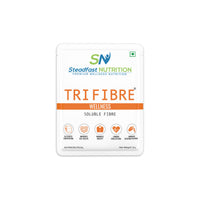When we talk about the simplest form of carbohydrates, we can separate them into two basic groups depending upon their digestibility in the GI tract. The first group (i.e. starch, simple sugars, and fructose) is known to be easily digestible and absorbed into the small intestine by hydrolysing enzymatic actions. These compounds can be mentioned as non-structural carbohydrates, non-fibrous polysaccharides or simple carbohydrates. The second group is (i.e. cellulose, hemicellulose, lignin, pectin and beta-glucans) resistant to digestion in the small intestine and require bacterial fermentation present in the large intestine. These compounds can be known as complex carbohydrates, non-starch polysaccharides or structural carbohydrates.
The non-starch polysaccharide can be further modified into two parts: soluble fibre and insoluble fibre. The division of these two fibres has been done based on their chemical, physical, and functional properties [2]. When we dissolve soluble fibre into the water, it tends to form a viscous gel. They are known to pass the digestion process of the small intestine and get further easily fermented by the microflora of the large intestine. They are mainly made up of pectins, gums, inulin-type fructose and some part of hemicelluloses. Insoluble fibres do not get dissolved in water under the GI tract. They are generally insoluble in water, that is why they do not form gels and makes the fermentation limited in the GI tract. Some of the very known examples of insoluble fibre are made up of lignin, cellulose and some hemicelluloses. Many fibres consisting of foods include roughly one-third soluble and two-thirds insoluble fibre [3].
Fibre found in the edible part of plant foods, eg. cereals, fruits, vegetables, dried peas, nuts, lentils, grains, etc.
Health Benefits of Fibre
Dietary fibre and whole grains are said to have a plentiful origin of nutrients including vitamins, minerals, and slow-releasing energy into the body. It includes phytochemicals such as phenolics, carotenoids, lignans, beta-glucan and inulin. These chemicals, produced by plants, do not fall into the essential nutrients category but have a major impact on human health [4]. The collective effects of these phytochemicals help increase nutrient content, and digestion properties are assumed to be the mechanism for dietary fibres. They are more famous for their beneficial effects on the treatment and prevention of Chronic Constipation, obesity and diabetes [5], reducing cardiovascular disease CVD [6] and the decreasing prevalence of certain types of cancer [7,8].
The RDA of fibre intake is 35-40 grams per day for adults or 20 grams for every 1,000 calories in the diet. It is the combination of both soluble and insoluble forms in a proper ratio. Usually, an insoluble to a soluble ratio of 3:1 is advisable for maintaining good health.
Why go for Tri Fibre?
Steadfast Tri Fibre is a well-known product in the market for chronic constipation, as it has multiple health benefits. Steadfast Tri Fibre is odourless, colourless and tasteless that can be consumed any time of the day. They have come up with a single serving pack, so it is easy to carry, and it is to be mixed with water and consumed with or without meals. Tri Fibre is heat resistant, which is why it can be added as an ingredient on salads, soups, pulses or vegetables. It consists of resistant maltodextrin, inulin and partially hydrolysed guar gum to enhance colon health and support the formation of good bacteria in the GI tract.
Added benefits of the key ingredients:-
Resistant maltodextrin is a well known soluble dietary fibre, which has a key role in maintaining a healthy intestine, blood glucose levels and serum lipid levels. It takes less amount of time to digest therefore it helps in maintaining serum glucose levels. It helps in controlling the appetite hormones that provide satiety and enhance bowel movement, further helping in relieving uncommon constipation. It has the added benefits of controlling triglycerides levels and cholesterol levels in our bodies.
Inulin is a familiar naturally occurring polysaccharide that is linked to the classes of dietary fibre called ‘fructans.’ Inulin is normally found in the roots or rhizomes inside a plant as they are used for storing energy. It drowns out from chicory roots, which are familiar for its prebiotic property. Prebiotic is well known for enhancing the health of good bacteria as it is indigestible in the uppermost part of the GI tract, but it is particularly fermented by bacteria, which further helps in improving health and overall well-being. It enhances colon health and helps in the detoxification of organs that at last reduce the risk of constipation.
Guar Gum is a plant polysaccharide chemically made up of the sugars ‘galactose’ and ‘mannose’. It has the property of dissolving in water and further forms a gel-like structure known to improve satiety. Daily consumption of this fibre enhances colon health as gut bacteria itself ferments this fibre for utilising to feed themselves. It helps in delaying the stomach emptying time that further improves the satiety, so we can say that it is good for the people who are looking forward to losing weight.
References
Tucker L.A., Thomas K.S. Increasing total fiber intake reduces risk of weight and fat gains in women. J. Nutr. 2009;139:576–581.
Sizer F., Whitney E. Nutrition: Concepts and Controversies. 11th. Thomson Wadsworth; Belmont, CA, USA: 2008.
Wong J.M., Jenkins D.J. Carbohydrate digestibility and metabolic effects. J. Nutr. 2007;137:2539S–2546S.
Liu R.H. Health benefits of fruit and vegetables are from additive and synergistic combinations of phytochemicals. Am. J. Clin. Nutr. 2003;78:517S–520S.
Weickert M.O., Pfeiffer A.F. Metabolic effects of dietary fiber consumption and prevention of diabetes. J. Nutr. 2008;138:439–442.
Liu S., Stampfer M.J., Hu F.B., Giovannucci E., Rimm E., Manson J.E., Hennekens C.H., Willett W.C. Whole-grain consumption and risk of coronary heart disease: Results from the Nurses’ Health Study. Am. J. Clin. Nutr.
Ferguson L.R., Chavan R.R., Harris P.J. Changing concepts of dietary fiber: Implications for carcinogenesis. Nutr. Cancer. 2001;39:155–169.
Terry P., Giovannucci E., Michels K.B., Bergkvist L., Hansen H., Holmberg L., Wolk A. Fruit, vegetables, dietary fiber, and risk of colorectal cancer. J. Natl. Cancer Inst. 2001;93:525–533.


